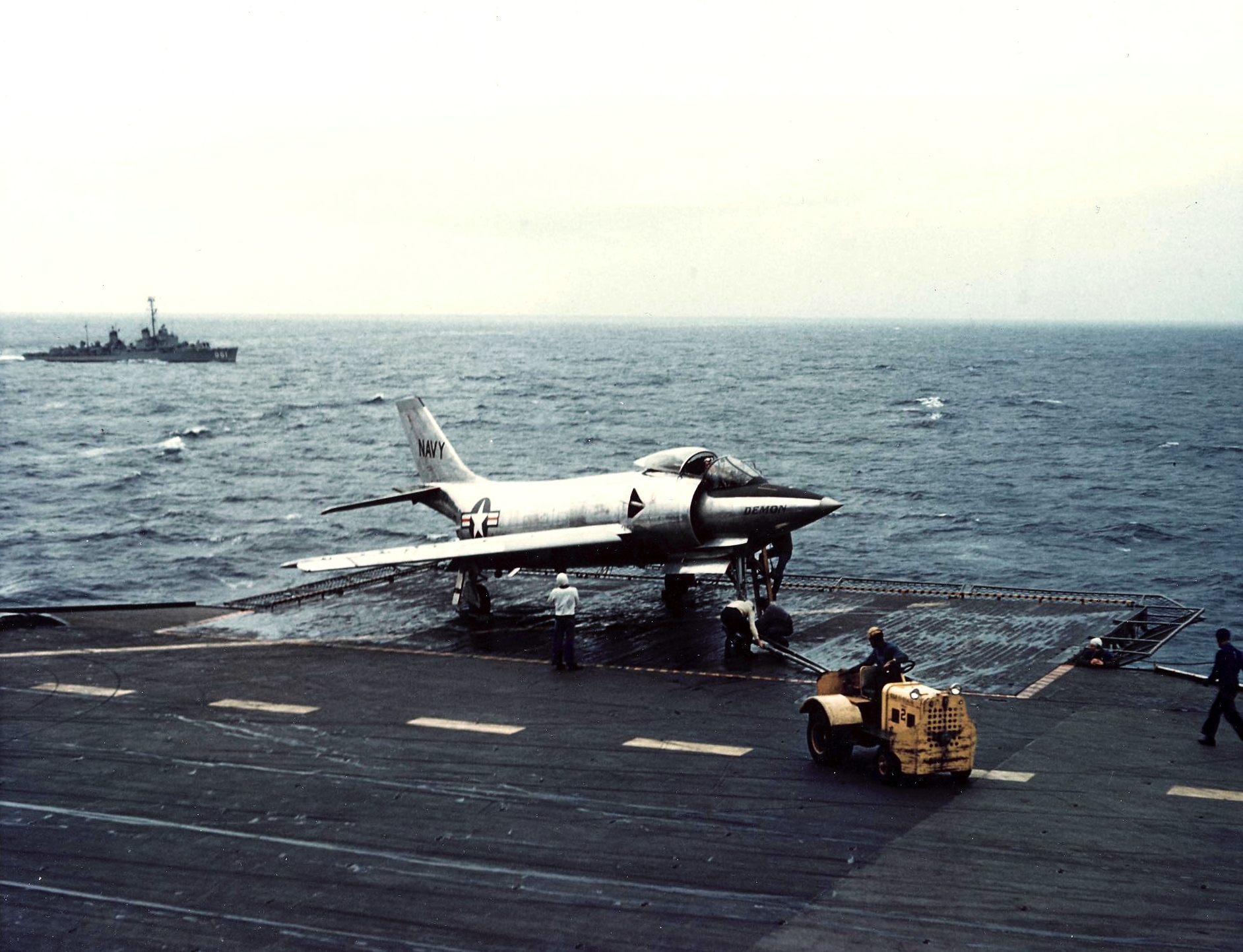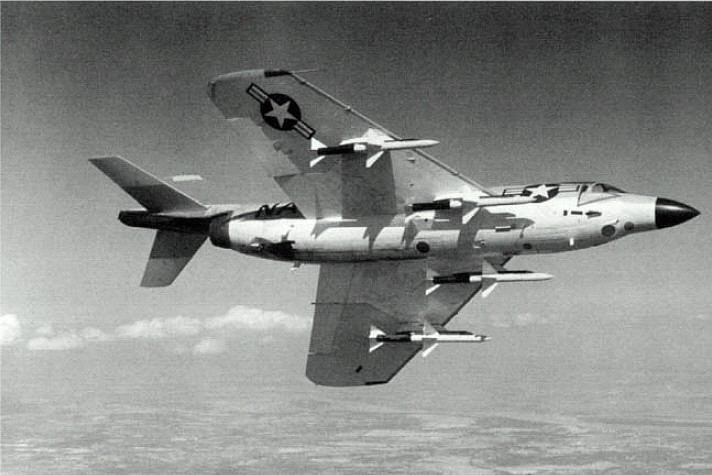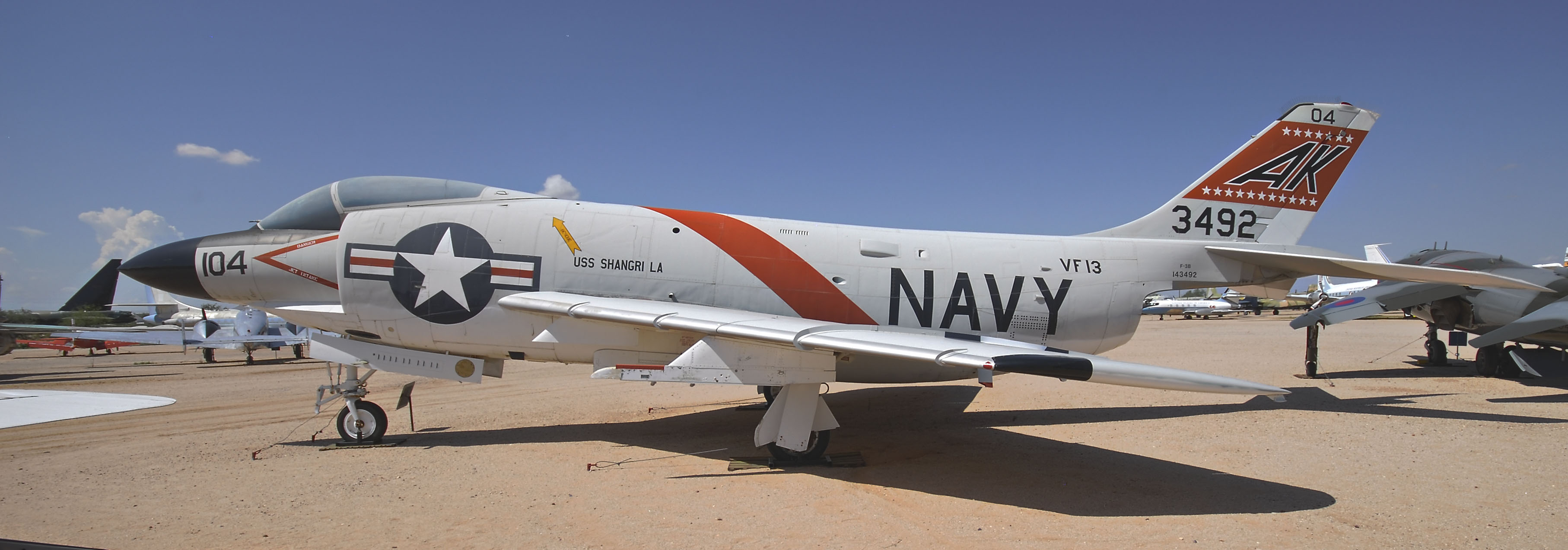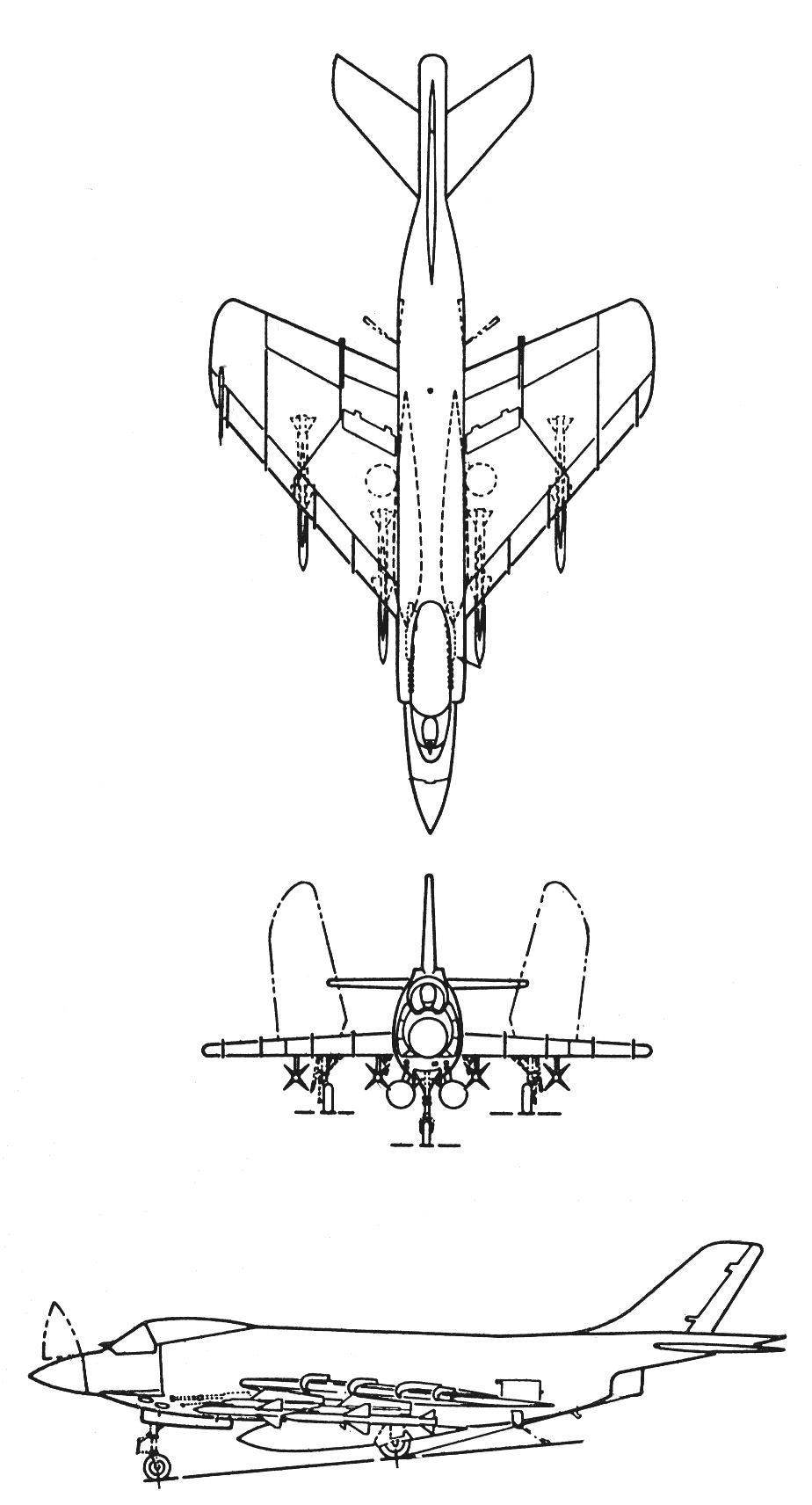McDonnell F3H-1N Demon on:
[Wikipedia]
[Google]
[Amazon]
The McDonnell F3H Demon is a subsonic swept-wing

 Development work began in 1949, using a swept wing from the start rather than adapting a straight-winged design as was done with the Grumman F9F Panther. A competing contract was also awarded for the
Development work began in 1949, using a swept wing from the start rather than adapting a straight-winged design as was done with the Grumman F9F Panther. A competing contract was also awarded for the
''Time'' magazine called the Navy's grounding of all Westinghouse-powered F3H-1 Demons a "fiasco", with 21 unflyable planes that could be used only for Navy ground training at a loss of $200 million. One high point of the J40 was the 1955 setting of an unofficial time-to-climb record, in a Demon, of in 71 seconds. The proposed F3H-1P reconnaissance version was never built. The J40 program was terminated sometime in 1955. All the aircraft it was to power were either canceled or redesigned to use other engines, notably the J57 and the J71. The F4D Skyray had been designed to accept larger engines in case the J40 did not work out, and was eventually powered by the Pratt & Whitney J57. But no other engine could simply be fitted into the old Demons, as both the wings and fuselage would have to be redesigned and enlarged. The best alternative turned out to be the

 ;XF3H-1
: Prototype single-seat clear-weather interceptor fighter. Powered by ( with afterburner)
;XF3H-1
: Prototype single-seat clear-weather interceptor fighter. Powered by ( with afterburner)
 ;F3H-2M
*BuNo 137078 -
;F3H-2M
*BuNo 137078 - "F3H Demon/145221."
''Pima Air & Space Museum.'' Retrieved: 15 January 2015.

''US Navy F-4 Phantom II MiG Killers 1965–70, Part 1'' (Osprey Combat Aircraft).
London: Osprey Publishing, 2001. . *Gunston, Bill. ''Fighters of the Fifties''. Cambridge, UK: Patrick Stephens Limited, 1981. .
"Naval Aircraft: Demon".
''Naval Aviation News'', March 1974, pp. 22–23. *Spick, Mike. "A Demon Possessed". '' Air Enthusiast'', Forty-three, 1991, pp. 40–49. Stamford, UK: Key Publishing. ISSN 0143-5450.
''F3H Demon Index''Demon Drivers
* {{Authority control Carrier-based aircraft F3H Demon McDonnell F03H Demon Low-wing aircraft Single-engined jet aircraft Aircraft first flown in 1951 Second-generation jet fighters
United States Navy
The United States Navy (USN) is the maritime service branch of the United States Armed Forces and one of the eight uniformed services of the United States. It is the largest and most powerful navy in the world, with the estimated tonnage ...
carrier-based
Carrier-based aircraft, sometimes known as carrier-capable aircraft or carrier-borne aircraft, are naval aircraft designed for operations from aircraft carriers. They must be able to launch in a short distance and be sturdy enough to withstand ...
jet
Jet, Jets, or The Jet(s) may refer to:
Aerospace
* Jet aircraft, an aircraft propelled by jet engines
** Jet airliner
** Jet engine
** Jet fuel
* Jet Airways, an Indian airline
* Wind Jet (ICAO: JET), an Italian airline
* Journey to Enceladus a ...
fighter aircraft
Fighter aircraft are fixed-wing military aircraft designed primarily for air-to-air combat. In military conflict, the role of fighter aircraft is to establish air superiority of the battlespace. Domination of the airspace above a battlefield ...
. The successor to the F2H Banshee, the Demon was originally designed to use the Westinghouse J40
The Westinghouse J40 was an early high-performance afterburning turbojet engine designed by Westinghouse Aviation Gas Turbine Division starting in 1946 to a US Navy Bureau of Aeronautics (BuAer) request. BuAer intended to use the design in severa ...
engine, but had to be redesigned to accept the Allison J71
The Allison J71 was a single spool turbojet engine, designed and built in the United States. It began development in 1948 as a much modified J35, originally designated J35-A-23.
Operational history
The Allison J71 turbojet powered the Douglas B ...
after the J40 suffered severe problems and was ultimately abandoned.Angelucci and Bowers 1987, p. 304. Though it lacked sufficient power for supersonic performance, it complemented day fighters such as the Vought F8U Crusader and Grumman F11F Tiger
The Grumman F11F/F-11 Tiger is a supersonic, single-seat carrier-based United States Navy fighter aircraft in operation during the 1950s and 1960s. Originally designated the F11F Tiger in April 1955 under the pre-1962 Navy designation system, i ...
as an all-weather, missile-armed interceptor
Interceptor may refer to:
Vehicles
* Interceptor aircraft (or simply "interceptor"), a type of point defense fighter aircraft designed specifically to intercept and destroy enemy aircraft
* Ford Crown Victoria Police Interceptor, a police car
* ...
until 1964.
It was withdrawn before it could serve in Vietnam when both it and the Crusader were replaced on ''Forrestal''-class and similar supercarriers by the McDonnell Douglas F-4 Phantom II. McDonnell's Phantom, which was equally capable against ground, fighter, and bomber targets, bears a strong family resemblance, as it was conceived as an advanced development of the Demon. The supersonic United States Air Force F-101 Voodoo was similar in layout, but was derived from the earlier XF-88 Voodoo
The McDonnell XF-88 Voodoo was a long-range, twinjet fighter aircraft with swept wings designed for the United States Air Force. Although it never entered production, its design was adapted for the subsequent supersonic F-101 Voodoo.
Design and ...
, which also influenced the Demon's layout.
Development

 Development work began in 1949, using a swept wing from the start rather than adapting a straight-winged design as was done with the Grumman F9F Panther. A competing contract was also awarded for the
Development work began in 1949, using a swept wing from the start rather than adapting a straight-winged design as was done with the Grumman F9F Panther. A competing contract was also awarded for the delta wing
A delta wing is a wing shaped in the form of a triangle. It is named for its similarity in shape to the Greek uppercase letter delta (Δ).
Although long studied, it did not find significant applications until the Jet Age, when it proved suitabl ...
Douglas F4D Skyray. The Skyray, with a top speed of , would become the Navy's first fighter to fly supersonic in level flight, while the Demon would never reach that level of performance. The original design work was based at its predecessor, the F2H Banshee. However, departing from its tradition of using two engines, the Demon would result in McDonnell's only single-engined carrier-based fighter, adopting under some Navy pressure, the Westinghouse J40
The Westinghouse J40 was an early high-performance afterburning turbojet engine designed by Westinghouse Aviation Gas Turbine Division starting in 1946 to a US Navy Bureau of Aeronautics (BuAer) request. BuAer intended to use the design in severa ...
engine. That engine was being promoted by the Navy for its next generation of aircraft, and was to have thrust of over 11,000 lbf (49 kN)—three times that of the engines in the F2H Banshee. It was the first swept-wing
A swept wing is a wing that angles either backward or occasionally forward from its root rather than in a straight sideways direction.
Swept wings have been flown since the pioneer days of aviation. Wing sweep at high speeds was first investigat ...
design produced by McDonnell and among the first U.S. aircraft to have missile armament.
The Navy desperately needed a high performance fighter to meet the challenge of the swept-wing MiG-15 encountered over Korea. Production of the F3H-1N was hastily ordered even before the first flight of the XF3H-1 prototype on 7 August 1951 by test pilot Robert Edholm. The first test flights of the operational design did not occur until January 1953, by which time the Korean War
, date = {{Ubl, 25 June 1950 – 27 July 1953 (''de facto'')({{Age in years, months, weeks and days, month1=6, day1=25, year1=1950, month2=7, day2=27, year2=1953), 25 June 1950 – present (''de jure'')({{Age in years, months, weeks a ...
was winding down.
The F3H Demon was originally designed around Navy's ambitious new Westinghouse J40
The Westinghouse J40 was an early high-performance afterburning turbojet engine designed by Westinghouse Aviation Gas Turbine Division starting in 1946 to a US Navy Bureau of Aeronautics (BuAer) request. BuAer intended to use the design in severa ...
which was to offer enough power to use just one engine in a number of new aircraft designs. But the engine would ultimately fail to produce the promised thrust or run reliably. The engine was a major disappointment, producing only half of the expected power. Worse, it was temperamental and unreliable. Of 35 F3H-1N aircraft flown with the J40 engine, eight were involved in major accidents. The first production Demons were grounded after the loss of six aircraft and four pilots.Boeing.com: F3H/F-3 Demon Fighter''Time'' magazine called the Navy's grounding of all Westinghouse-powered F3H-1 Demons a "fiasco", with 21 unflyable planes that could be used only for Navy ground training at a loss of $200 million. One high point of the J40 was the 1955 setting of an unofficial time-to-climb record, in a Demon, of in 71 seconds. The proposed F3H-1P reconnaissance version was never built. The J40 program was terminated sometime in 1955. All the aircraft it was to power were either canceled or redesigned to use other engines, notably the J57 and the J71. The F4D Skyray had been designed to accept larger engines in case the J40 did not work out, and was eventually powered by the Pratt & Whitney J57. But no other engine could simply be fitted into the old Demons, as both the wings and fuselage would have to be redesigned and enlarged. The best alternative turned out to be the
Allison J71
The Allison J71 was a single spool turbojet engine, designed and built in the United States. It began development in 1948 as a much modified J35, originally designated J35-A-23.
Operational history
The Allison J71 turbojet powered the Douglas B ...
engine which was also used in the Douglas B-66 Destroyer. Subsequent F3Hs with this powerplant were designated the F3H-2N. In service, the J71 proved problematic, providing insufficient power for an aircraft of the Demon's size. The engine also suffered from frequent flameouts and compressor stall A compressor stall is a local disruption of the airflow in the compressor of a gas turbine or turbocharger. A stall that results in the complete disruption of the airflow through the compressor is referred to as a compressor surge. The severity of t ...
s. The first J71-powered Demon flew in October 1954. Another significant problem was the reliability of the ejection seat
In aircraft, an ejection seat or ejector seat is a system designed to rescue the aircraft pilot, pilot or other aircrew, crew of an aircraft (usually military) in an emergency. In most designs, the seat is propelled out of the aircraft by an ex ...
s: initial versions were found to be unreliable and were eventually replaced with Martin-Baker ejection seats that were becoming the standard Navy seat of choice due to their higher performance at low altitude and better reliability.
Despite the problems, the Navy ordered 239 F3H-2s, and the first were deployed in March 1956. 519 Demons were built up to the end of production in November 1959. It was not the Navy's first all-weather interceptor
Interceptor may refer to:
Vehicles
* Interceptor aircraft (or simply "interceptor"), a type of point defense fighter aircraft designed specifically to intercept and destroy enemy aircraft
* Ford Crown Victoria Police Interceptor, a police car
* ...
with radar (the AN/APG-51 air interception set was used first on the F2H-4 Banshee). The F3H-2 Demon had the AN/APG-51A, later upgraded to the 51-B version with a tunable magnetron then on to 51-C with better counter-measures in the receiver.
The F3H-2N's standard armament was four 20 mm (.79 in) Colt Mk 12 cannons. In later years, the upper two cannons were often omitted to save weight. Later models, redesignated F3H-2M, were equipped to fire the Raytheon AAM-N-2 Sparrow and later the Sidewinder air-to-air missile
The newest and the oldest member of Rafael's Python family of AAM for comparisons, Python-5 (displayed lower-front) and Shafrir-1 (upper-back)
An air-to-air missile (AAM) is a missile fired from an aircraft for the purpose of destroying a ...
s. Deployed aircraft carried both types of missiles, the Sparrow on the inboard rails and the Sidewinder outboard. Cannons were not used in carrier air defense applications, but they were installed and armed when situations (such as the Cuban Missile Crisis
The Cuban Missile Crisis, also known as the October Crisis (of 1962) ( es, Crisis de Octubre) in Cuba, the Caribbean Crisis () in Russia, or the Missile Scare, was a 35-day (16 October – 20 November 1962) confrontation between the United S ...
) dictated, and where the aircraft might be deployed against surface targets.
A reconnaissance
In military operations, reconnaissance or scouting is the exploration of an area by military forces to obtain information about enemy forces, terrain, and other activities.
Examples of reconnaissance include patrolling by troops (skirmisher ...
version, the F3H-2P, was proposed, but never built. It remained the Navy's front-line fighter until 1962, when it was succeeded by the F-4 Phantom II
The McDonnell Douglas F-4 Phantom II is an American tandem two-seat, twin-engine, all-weather, long-range supersonic jet interceptor and fighter-bomber originally developed by McDonnell Aircraft for the United States Navy.Swanborough and Bow ...
(which was a development of a proposed "Super Demon", a larger and much heavier version of the F3H). Developed during the Korean War to counter the MiG-15, it did not claim any aerial victories with missiles or dogfights, although it flew over Lebanon
Lebanon ( , ar, لُبْنَان, translit=lubnān, ), officially the Republic of Lebanon () or the Lebanese Republic, is a country in Western Asia. It is located between Syria to the north and east and Israel to the south, while Cyprus li ...
and Quemoy in 1958.
In 1962, the F3H was redesignated F-3. The F3H-2N became the F-3C, the F3H-2M became MF-3B, and the F3H-2 changed to F-3B.
The last Demon-equipped squadron, VF-161 'Chargers', traded their F-3s for F-4 Phantom IIs in September 1964.
Due to excellent visibility from the cockpit, the Demon earned the nickname "The Chair". Demon pilots were known colloquially as "Demon Drivers" and those who worked on the aircraft were known as "Demon Doctors". The unfavorable power-to-weight ratio gave rise to the less flattering nickname "lead sled", sometimes shortened to "sled".
Variants

 ;XF3H-1
: Prototype single-seat clear-weather interceptor fighter. Powered by ( with afterburner)
;XF3H-1
: Prototype single-seat clear-weather interceptor fighter. Powered by ( with afterburner) Westinghouse XJ40
The Westinghouse J40 was an early high-performance afterburning turbojet engine designed by Westinghouse Aviation Gas Turbine Division starting in 1946 to a US Navy Bureau of Aeronautics (BuAer) request. BuAer intended to use the design in severa ...
-WE-6 engine. Two built.Angelucci and Bowers 1987, p. 305.
;F3H-1N
: Initial production version. Single-seat all-weather fighter version, powered by ( with afterburner) J40-WE-22 engine. 58 built.
;F3H-1P
: Proposed reconnaissance version of F3H-1. Never built.
;F3H-2N
: All-weather fighter powered by ( Allison J71
The Allison J71 was a single spool turbojet engine, designed and built in the United States. It began development in 1948 as a much modified J35, originally designated J35-A-23.
Operational history
The Allison J71 turbojet powered the Douglas B ...
-A-2 engine and equipped to carry AIM-9 Sidewinder air-to-air missiles. 239 built. Redesignated F-3C in 1962.Angelucci and Bowers 1957, pp. 304–306.
;F3H-2M
: Derivative of F3H-2N armed with four AIM-7 Sparrow air-to-air missiles. 80 built. Redesignated ''MF-3B'' in 1962.
;F3H-2
: Single-seat strike fighter version, retaining Sidewinder and Sparrow capability of the −2M/N and adding payload of 6,000 lb (2,730 kg) bombs or rockets. 239 built. Redesignated ''F-3B'' in 1962.
;F3H-2P
: Proposed photo-reconnaissance version of −2. Unbuilt.
;F3H-3
: Proposed version with the General Electric J73 engine. Unbuilt.
Operators
; *United States Navy
The United States Navy (USN) is the maritime service branch of the United States Armed Forces and one of the eight uniformed services of the United States. It is the largest and most powerful navy in the world, with the estimated tonnage ...
Aircraft on display
 ;F3H-2M
*BuNo 137078 -
;F3H-2M
*BuNo 137078 - National Museum Naval Aviation
The National Naval Aviation Museum, formerly known as the National Museum of Naval Aviation and the Naval Aviation Museum, is a military and aerospace museum located at Naval Air Station Pensacola, Florida.
Founded in 1962 and moved to its curr ...
at Naval Air Station Pensacola, Florida
Florida is a state located in the Southeastern region of the United States. Florida is bordered to the west by the Gulf of Mexico, to the northwest by Alabama, to the north by Georgia, to the east by the Bahamas and Atlantic Ocean, and to ...
.
;F3H-2N
*BuNo 133566 - USS Intrepid Museum in New York City, New York
New York, often called New York City or NYC, is the List of United States cities by population, most populous city in the United States. With a 2020 population of 8,804,190 distributed over , New York City is also the L ...
.
*BuNo 145221 - Pima Air & Space Museum, adjacent to Davis-Monthan AFB in Tucson, Arizona
, "(at the) base of the black ill
, nicknames = "The Old Pueblo", "Optics Valley", "America's biggest small town"
, image_map =
, mapsize = 260px
, map_caption = Interactive map ...
.''Pima Air & Space Museum.'' Retrieved: 15 January 2015.
Specifications (F3H-2)

See also
References
Notes
Bibliography
*Angelucci, Enzo andPeter M. Bowers
Peter M. Bowers (May 15, 1918 – April 27, 2003) was an aeronautical engineer, airplane designer, and a journalist and historian specializing in the field of aviation.
. ''The American Fighter''. Sparkford, Somerset, UK: Haynes Publishing Group, 1987. .
*Dorr, Robert F. "McDonnell F3H Demon". ''Aeroplane
An airplane or aeroplane (informally plane) is a fixed-wing aircraft that is propelled forward by thrust from a jet engine, propeller, or rocket engine. Airplanes come in a variety of sizes, shapes, and wing configurations. The broad spectr ...
'', Volume 36, No. 3, March 2008, pp. 58–73. London: IBC.
*Elward, Brad A. and Peter Davies''US Navy F-4 Phantom II MiG Killers 1965–70, Part 1'' (Osprey Combat Aircraft).
London: Osprey Publishing, 2001. . *Gunston, Bill. ''Fighters of the Fifties''. Cambridge, UK: Patrick Stephens Limited, 1981. .
"Naval Aircraft: Demon".
''Naval Aviation News'', March 1974, pp. 22–23. *Spick, Mike. "A Demon Possessed". '' Air Enthusiast'', Forty-three, 1991, pp. 40–49. Stamford, UK: Key Publishing. ISSN 0143-5450.
External links
''F3H Demon Index''
* {{Authority control Carrier-based aircraft F3H Demon McDonnell F03H Demon Low-wing aircraft Single-engined jet aircraft Aircraft first flown in 1951 Second-generation jet fighters